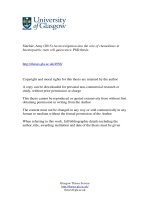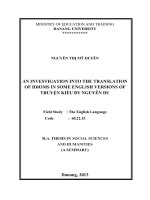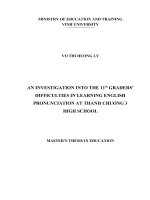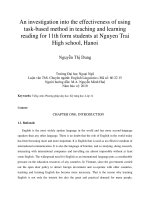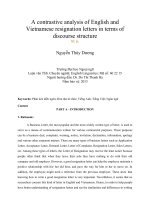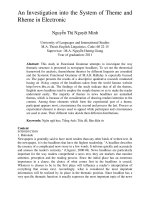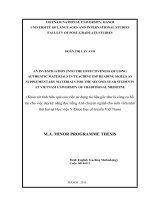An investigation into the pragmatic features in the language products of high functioning autisti
Bạn đang xem bản rút gọn của tài liệu. Xem và tải ngay bản đầy đủ của tài liệu tại đây (2 MB, 107 trang )
THE UNIVERSITY OF DANANG
UNIVERSITY OF FOREIGN LANGUAGE STUDIES
NGUYỄN LÊ THỦY TIÊN
AN INVESTIGATION INTO THE PRAGMATIC
FEATURES IN THE LANGUAGE PRODUCTS
OF HIGH-FUNCTIONING AUTISTIC
INDIVIDUALS: A CASE-STUDY IN THE USA
MASTER THESIS IN
LINGUISTICS AND CULTURAL STUDIES
OF FOREIGN COUNTRIES
Da Nang, 2020
THE UNIVERSITY OF DANANG
UNIVERSITY OF FOREIGN LANGUAGE STUDIES
NGUYỄN LÊ THỦY TIÊN
AN INVESTIGATION INTO THE PRAGMATIC
FEATURES IN THE LANGUAGE PRODUCTS
OF HIGH-FUNCTIONING AUTISTIC
INDIVIDUALS: A CASE-STUDY IN THE USA
Major: ENGLISH LINGUISTICS
Code: 822.02.01
MASTER THESIS IN
LINGUISTICS AND CULTURAL STUDIES
OF FOREIGN COUNTRIES
Supervisor: VÕ THANH SƠN CA, Ph.D
Da Nang, 2020
i
ACKNOWLEDGEMENT
Thank you Dr. Vo Thanh Son Ca, for the rapid and infinite help you
provided me during the course of my research from the very beginning.
Thank you Becky and Nadine, for lending me an ear when I need to talk and
believing that I can make a difference.
Thank you Anh and Linh, for your assistance during my research.
And thank you to my parents, who provided me with the care I needed.
iii
ABSTRACT
One of the most universal traits of high functioning autistic people is the
difficulty in language production. This creates several problems for autistic people
when interacting with neurotypicals, putting them at risk of being discriminated
against and misunderstood (Asperger, 1991). However, little has been done on this
phenomenon, as most previous research on language of autistic people only
produced results based on experiments in artificial environments (Fine, Bartolucci,
Szatmari, & Ginsberg, 1994; Mitchell, Saltmarsh, & Russell, 1997; Surian, BaronCohen, & Van der Lely, 1996). Moreover, the subjects of these studies were almost
always autistic children and adolescents, leaving a gap in the literature which is the
language of autistic adults. Therefore, this research aimed to analyze the pragmatic
features in the spoken and written language products of high-functioning autistic
people, through the case study of Christian Weston Chandler (CWC), a highfunctioning autistic man who did not receive proper treatment for his autism
throughout his life. Specifically, this study attempted to identify the features of
literal and non-literal utterances in CWC‘s spoken and written language and
examined the connections between CWC‘s spoken and written language. Based on
the Discourse Analysis method (Salkind, 2010), the data from 37 phone calls and
290 emails between CWC and several different neurotypicals were qualitatively
analyzed. These phone calls and emails were analyzed separately in order to
identify the main features of CWC‘s spoken language and written language. CWC‘s
spoken language were then compared with his written language in order to examine
the connections between his spoken and written language. The findings suggested
that both CWC‘s spoken and written language shared two main features: The first is
the mismatch between the non-literal utterances in the neurotypicals‘ statements and
the literal utterances in CWC‘s responses, and the second is the conformation of the
responses to the intention behind the neurotypicals‘ statements. However, the literal
- non-literal conformation was more apparent in written texts than in spoken texts,
iv
and the literal – non-literal mismatch was more apparent in spoken texts than in
written texts. Furthermore, there was a connection between CWC‘s level of stress
and the increase of the literal – non-literal mismatch in CWC‘s spoken language,
while there was no such increase in his written language. There are also two other
features, each of which was unique to either CWC‘s spoken or written language.
They are the tendency to repeat the neurotypicals‘ statements word-by-word (in
spoken language), and the tendency to group multiple responses to the neuropicals‘
statements into one paragraph without clarifying which statement was being
addressed (in written language). However, there was a few instances in CWC‘s
written language when he also repeated the neurotypicals‘ statements, and this
tendency was somewhat linked to the decrease in grouping tendency in CWC‘s
response – that is – CWC was more likely to separate his responses with ordinal
adverbs or numbers if the neurotypicals also did the same in their emails. Overall,
although there were instances when CWC‘s responses conformed to the intention
behind the neurotypicals‘ statements, the frequency of this happening was low and
inconsistent. Thus, it is advisable for teachers, medical staff, social workers and the
general public to limit the use of non-literal utterances when communicating with
high-functioning autistic people. During communication, they should express their
point as clear and concise as possible. It is also necessary that they should not
assume
bad
intention
from
high-functioning
autistic
people
when
miscommunication occurs. Medical staff and social workers can also refer to the
results of this study to create a framework for effective methods of treatment and
assistance for high-functioning autistic people.
Keyword: high-functioning autism; language products; pragmatics; case-study,
non-literal utterance
v
TABLE OF CONTENTS
ACKNOWLEDGEMENT ........................................................................................ i
STATEMENT OF AUTHORSHIP ........................................................................ ii
ABSTRACT ............................................................................................................. iii
TABLE OF CONTENTS..........................................................................................v
LIST OF ABBREVIATIONS .............................................................................. viii
LIST OF TABLES ................................................................................................... ix
LIST OF FIGURES ..................................................................................................x
Chapter One. INTRODUCTION ............................................................................1
1.1. RATIONALE .......................................................................................................1
1.2. AIMS AND OBJECTIVES .................................................................................5
1.2.1. Aims ..............................................................................................................5
1.2.2. Objectives .....................................................................................................5
1.3. RESEARCH QUESTIONS..................................................................................6
1.4. SCOPE OF THE STUDY ....................................................................................6
1.5. SIGNIFICANCE OF THE STUDY .....................................................................6
1.6. ORGANIZATION OF THE STUDY ..................................................................6
Chapter
Two.
LITERATURE
REVIEW
AND
THEORETICAL
BACKGROUND .......................................................................................................8
2.1. LITERATURE REVIEW.....................................................................................8
2.2. THEORETICAL BACKGROUND: ....................................................................9
2.2.1. High-functioning autism and related concepts .............................................9
2.2.1.1. Theory of mind ......................................................................................9
2.2.1.2. Autism .................................................................................................10
2.2.2. Speech Act ..................................................................................................12
2.2.2.1. Definition of Speech Act .....................................................................12
2.2.2.2. Structure of a speech act ......................................................................12
2.2.2.3. Illocutionary Force ..............................................................................13
vi
2.2.2.4. Explicit performative vs implicit performative: ..................................13
2.2.2.5. Indirect speech act ...............................................................................14
2.2.2.6. Literal speech act vs non-literal speech act .........................................15
2.2.3. A description of CWC ................................................................................17
2.3. SUMMARY .......................................................................................................18
Chapter Three. METHODOLOGY ......................................................................19
3.1. RESEARCH DESIGN .......................................................................................19
3.2. RESEARCH METHODS...................................................................................19
3.3. PROCEDURES ..................................................................................................20
3.3.1. Data Collection ...........................................................................................20
3.3.2. Data coding .................................................................................................23
3.3.2.1. Coder ...................................................................................................23
3.3.2.2. Coder training ......................................................................................23
3.3.2.3. Reliability estimate of coding .............................................................25
3.3.3. Data analysis ...............................................................................................26
3.4. SUMMARY .......................................................................................................30
Chapter Four. FINDINGS AND DISCUSSIONS ................................................31
4.1. FEATURES OF LITERAL AND NON-LITERAL UTTERANCES IN
CWC‘S SPOKEN LANGUAGE ..............................................................................31
4.1.1. Features of literal and non-literal utterances in CWC‘s phone calls from
August 3rd, 2009 to November 10th, 2009 ...............................................................31
4.1.1.1. Phone calls between CWC and Kacey (from August 3rd, 2009 to
November 10th, 2009)................................................................................................32
4.1.1.2. Phone calls between CWC and Matthew (27th phone call,
November 4th, 2009)..................................................................................................43
4.1.1.3. The 28 phone calls from August 3rd, 2009 to November 10th, 2009 .48
4.1.2. Features of literal and non-literal utterances in CWC‘s phone calls from
January 22nd, 2010 to February 25th, 2010 ................................................................50
4.1.3. Features of literal and non-literal utterances in CWC‘s 38 phone calls .....56
vii
4.2. FEATURES OF LITERAL AND NON-LITERAL UTTERANCES IN
CWC‘S WRITTEN LANGUAGE ............................................................................57
4.3. THE CONNECTIONS BETWEEN CWC‘S SPOKEN AND WRITTEN
LANGUAGE.............................................................................................................66
4.4. DISCUSSION ....................................................................................................70
4.5. SUMMARY .......................................................................................................76
Chapter Five. CONCLUSIONS AND IMPLICATIONS ....................................77
5.1. CONCLUSIONS ................................................................................................77
5.2. IMPLICATIONS................................................................................................83
5.2.1. To teachers ..................................................................................................84
5.2.2. To medical staff and social workers ...........................................................84
5.2.3. To the general public ..................................................................................85
5.3. LIMITATIONS OF THE STUDY AND SUGGESTIONS FOR FURTHER
RESEARCH ..............................................................................................................85
REFERENCES
QUYẾT ĐỊNH GIAO ĐỀ TÀI LUẬN VĂN (Bản sao)
viii
LIST OF ABBREVIATIONS
CWC : Christian Weston Chandler
LC
: Liquid Chris
ix
LIST OF TABLES
Number
Name of Tables
of Tables
3.1.
3.2.
3.3.
3.4.
4.1.
Symbols used during the data coding process of CWC‘s
spoken language and their meanings
Symbols used during the data coding process of CWC‘s
written language and their meanings.
Results of two coders from the coding process of CWC‘s
spoken language
Results of two coders from the coding process of CWC‘s
written language
Distribution of the instances of the three features of CWC‘s
spoken language in each phone call with Kacey
Page
24
25
25
25
37
Distribution of the instances of the three features of CWC‘s
4.2.
spoken language in the 28 phone calls from August 3rd,
49
2009 to November 10th, 2009
4.3.
4.4.
5.1.
Distribution of the instances of the three features of CWC‘s
spoken language in each phone call with Alec
Distribution of the instances of the three features of CWC‘s
written language in each Mailbag section
Features of CWC‘s spoken and written language and their
relationship to each other
55
64
79
x
LIST OF FIGURES
Number of
Name of Figures
Figures
Page
The timeline of the main events of CWC‘s life from 2008
3.1.
to
2012
(taken
and
edited
from
21
/>3.2.
4.1.
4.2.
4.3.
4.4.
Details of the data collected for analysis
Numbers of the three features of CWC‘s spoken language
in the 28 phone calls
Numbers of the three features of CWC‘s spoken language
in the phone call with Matthew
Numbers of the three features of CWC‘s spoken language
in the phone call with Alec
Numbers of the three features of CWC‘s written language
in the 290 phone calls
22
37
47
54
63
1
Chapter One
INTRODUCTION
This chapter provides the rationale of the study, together with the aims,
objectives, scope of study and the significance of the study. This chapter also aims
to introduce the basic framework for the whole research.
1.1. RATIONALE
Language production does not only involve the comprehension of the
language itself, but also a good understanding of the context involved in the
communication environment, and how to maintain the conversation in a way that
lines up with the expectation of the people involved (for example, how to help
people save face). The latter depends largely on the ability to understand other
people‘s points of view, or the ability to ―put yourself into someone else‘s shoes‖.
This ability is developed through the human‘s natural ability to interact and bond
with people.
Autistic people are born without this natural ability. Even high-functioning
autistic people do not innately understand how to relate to other people. Therefore,
their language production is seriously hampered. They only have the understanding
of language‘s meaning in its most literal sense, without any understanding of how to
apply language in a socially appropriate way. As a result, they are forced to develop
language in the way that they think is right, which can be completely different from
the ―right‖ way neurotypical people use their language. This creates several
problems for autistic people when communicating with the world. High-functioning
autistic people are less affected by autism and are better at developing intelligence.
Some high-functioning autistic people have the IQ level of above average.
However, they are still unable to connect with neurotypicals properly; therefore,
their language problem remains.
It is very hard, however, for neurotypicals to understand the difficulty that
autistic people face, since the ability to understand other people is an innate ability
2
every neurotypical person has. As a result, neurotypicals fail to acknowledge that
autistic people have a significant problem with communication, and most
neurotypicals think this inability to communicate appropriately is due to the autistic
people being deliberately rude and disrespectful to social rules instead of having an
actual problem. This discrimination is much more profound in high-functioning
autistic people, who display less noticeable traits of autism and can be mistaken for
neurotypicals. It is also worth noticing that this ability, though innate, is extremely
complex and difficult to explain in a literal way; thus, even when neurotypicals are
able to acknowledge the communication problem, it is still very difficult and
frustrating for the neurotypicals to explain to autistic people how to communicate
appropriately.
Consider this example of Attwood (2007, p.11-12), depicting Jack, a boy
with Asperger‘s syndrome, a type of high-functioning autism. This conversation is
supposed to take place during the birthday party of Jack‘s friend Alicia, between
Jack and the girl‘s mother. This is the first time the mother has met Jack, and she
does not know about Jack‘s mental condition:
[…] And here he was, a solitary figure clutching a birthday card and present
which he immediately gave to Alicia‟s mother. […]. „You must be Jack,‟ she said
and he simply replied with a blank face, „Yes‟. She smiled at him, and was about to
suggest he went into the garden to join Alicia and her friends when he said,
“Alicia‟s birthday present is one of those special dolls that my mum says every girl
wants, […], but what I really wanted to get her was some batteries. Do you like
batteries? I do, I have a hundred and ninety-seven batteries. Batteries are really
useful. What batteries do you have in your remote controllers?” Without waiting for
a reply, he continued, „I have a special battery from Russia. My dad‟s an engineer
[…] and he came home with six triple-A batteries for me with Russian writing on
them. They are my favourite. When I go to bed I like to look at my box of batteries
and sort them in alphabetical order before I go to sleep. I always hold one of my
Russian batteries as I fall asleep. […]. How many batteries do you have?‟ She
3
replied, “Well, I don‟t know, but we must have quite a few…”, and felt unsure what
to say next.[…]
Clearly, in this scenario, there is a mismatch in communication between Jack
and Alicia‘s mother. When the mother says ―You must be Jack”, her intention is to
strike a conversation and request for more information about Jack. Jack, however,
can only see the semantic surface of the question and answer with a simple ―yes”.
And without considering his listener‘s interest, Jack starts the conversation with his
present, and drives the conversation toward the topic of batteries, one of his
hobbies. Jack disregards whether the mother is interested in battery, and whether the
mother can listen to him; he simply continues the conversation as he sees fit.
Furthermore, when he asks ―What batteries do you have in your remote controllers”
and ―How many batteries do you have”, he holds no complicated pragmatic
intention; he only wants her to answer the question literally. This turns the
conversation to a very awkward direction; and without prior knowledge of Jack‘s
autism, the mother may misunderstand Jack‘s intention, thinking he has no
communication manner.
This is a rather obvious example of the differences between autistic people
and neurotypicals in terms of language. In more complex communicative situations,
the differences can manifest in more subtle ways. The subtlety is harder to detect
and creates more room for potential misunderstanding and inconvenience.
One extremely peculiar case of high-functioning autism is Christian Weston
Chandler (CWC). CWC is a high-functioning autistic man whose autism was not
properly treated and who is infamous on the Internet for his autism. Born on 24th
February, 1982, in Virginia, USA, to Robert and Barbara Chandler, CWC displayed
signs of autism as a child and received a diagnosis for autism. His autism was
probably caused by a gene defect due to his parents‘ old age (Robert was 55 years
old and Barbara was 41 years old when CWC was born). Robert and Barbara,
however, refused to seek proper treatment for CWC‘s autism, resorting to bribing
CWC with toys to get him to speak and paying children in CWC‘s school to
4
befriend him. Robert rejected the offer of CWC‘s primary school to send him to a
special education school, for fear of discrimination. Due to his parents‘ coddling,
CWC was unable to learn how to behave properly. His erratic behavior, strange
manner of speech, and the comic Sonichu that he created soon caught the attention
of the internet. Several malicious people, or ―internet trolls‖, started to tease and
harass CWC to get a reaction from him. The harassing went on for several years,
causing significantly negative and lasting impact on CWC‘s life.
CWC has several traits of a typical high-functioning autistic person such as
the
followings
(information
retrieved
from
/>1. Having no theory of mind, the ability to understand others' thoughts, feelings,
ideas, intents… and the understanding that others‘ thought and feeling might
be different than himself.
2. Understanding words and concept only in their literal sense. This trait is
apparent in CWC‘s interaction with people.
3. Extreme gullibility, which is the main reason why he fell prey to trolls.
4. Lack of social awareness and empathy, which can be seen in his behavior
toward Megan Schroeder, a friend of CWC that cut tie with him after he
published a nude drawing of her and refused to take responsibility for his
action.
5. Delayed mental development. Throughout his interaction, and particularly
his communication, he displays the mental capability of someone far younger
than his age.
6. Extremely narrow range of interest, which can be seen in his obsession with
toys, finding a girlfriend and creating his comic Sonichu.
7. Fear and resistance to change, which can be seen from his refusal to leave
home and find a job and part ways with his toys.
In addition to these traits, CWC‘s autism was left untreated due to his
parents‘ refusal to seek professional help. This led to one of the purest
5
manifestations of high-functioning autism that can be seen in an autistic person,
making CWC a good subject for analysis. Moreover, information about CWC‘s life
is publicly available at the website CWCki ( />It is rare to see such detailed documentation on an autistic person‘s life. Therefore,
CWC‘s life provides good resources to study the difficulties that high-functioning
autistic people face when communicating with other people. Through the analysis
of CWC‘s life, one can expect to discover valuable information on how highfunctioning autistic people communicate and the misunderstandings that they
encounter everyday.
For all the above-mentioned reasons, the researcher decided to choose to
carry out the research study titled ‗An Investigation into the Pragmatic Features in
the Language Products of High-Functioning Autistic Individual: a Case-Study in the
USA‘.
1.2. AIMS AND OBJECTIVES
1.2.1. Aims
This study aims to analyze the spoken and written language features of CWC
in terms of pragmatics, specifically the literal and non-literal utterances in CWC‘s
speech act. In particular, the study analyzes spoken and written discourse between
CWC and the neurotypicals with whom he interacted.
1.2.2. Objectives
To achieve the aim of the study, the following objectives have to be
accomplished:
1. Identify the features of literal and non-literal utterances in CWC‘s spoken
language.
2. Identify the features of literal and non-literal utterances in CWC‘s written
language.
3. Identify the connections between CWC‘s spoken and written language in
terms of the use of literal and non-literal utterances.
6
1.3. RESEARCH QUESTIONS
To achieve the aims and objectives mentioned above, the study aims to find
the answers to the following research questions:
1. What are the features of literal and non-literal utterances in CWC‘s
spoken language?
2. What are the features of literal and non-literal utterances in CWC‘s
written language?
3. What are the connections between CWC‘s spoken and written language?
1.4. SCOPE OF THE STUDY
This study is limited to the analysis of the language products of CWC. This
study is limited to a case study of one specific person. Hence, the findings may not
be generalized to every high-functioning autistic person. Furthermore, CWC is a
high-functioning autistic man. Thus, this study may not be representative of lowerfunctioning autistic people.
This study also aims to collect data of CWC‘s language products between the
period of 2008 and 2012, since this is the period that saw the most noteworthy
interaction between CWC and the neurotypicals he interacted with on the Internet.
Data beyond this period is not taken into consideration.
1.5. SIGNIFICANCE OF THE STUDY
This study aims to provide useful and detailed information about the way
high-functioning autistic people produce language and, from these findings, explain
the misunderstandings in communication between high-functioning autistic people
and neurotypicals, from obvious to subtle. The results of the study can provide
useful insights for educators, medical staff, social workers and the general public so
that they can come up with ways to better interact with high-functioning autistic
people and help them integrate into society.
1.6. ORGANIZATION OF THE STUDY
The study is presented in the following parts:
7
Chapter 1: Introduction
This chapter aims to introduce the rationale of the study and to present the
aim, objectives and research questions of the study. The outline of this paper is also
included in this chapter.
Chapter 2: Literature Review and Theoretical Background
This chapter provides a detailed outline of the theoretical background which
clarifies some important concepts of the study. Previous studies related to language
use in high-functioning autistic people are also presented in this chapter.
Chapter 3: Research Methods
This chapter aims to present the methodology of this study, including
research methods, data collection and data analysis.
Chapter 4: Findings and Discussions
This chapter presents the results and discussion of the study. In this chapter,
the answers to the research questions raised in Chapter 1 are provided through
qualitative analysis.
Chapter 5: Conclusions and Implications
This chapter presents the conclusions from the general findings of the study,
as well as limitations and suggestions for future research.
8
Chapter Two
LITERATURE REVIEW AND THEORETICAL BACKGROUND
This chapter aims to provide a description of some notable previous research
on languages in autistic people, in order to gain an overall view of the state of
affairs in this research area, and to pinpoint what further research needs to be
conducted. This chapter will also introduce important theoretical background for
this study.
2.1. LITERATURE REVIEW
There have been several research studies on the topic of language in autistic
people. Almost studies focus on some general language features of autistic people,
particularly autistic children.
It has been suggested that high-functioning autistic adolescents speak in
monologue tone during interpersonal conversation such as interviews (Ghaziuddin
& Gerstein, 1996; Ramberg, Ehlers, Nyden, Johansson, & Gillberg, 1996) and have
problems providing appropriate response to questions and clear references to people
and places in conversations (Adams, Green, Gilchrist, & Cox, 2002; Fine,
Bartolucci, Szatmari, & Ginsberg, 1994). Surian, Baron-Cohen, and Van der Lely
(1996) added that they also have difficulties judging the amount of information to
be included in the responses.
In terms of language reception, autistic people have problems interpreting
figurative speech, particularly with idiom, metaphor and irony (Happé, 1993;
Kerbel & Grunwell, 1998; Martin & McDonald, 2004). Specifically, autistic people
are not good at interpreting the intention behind a speech act of the speakers and
tend to interpret utterance literally (Mitchell, Saltmarsh, & Russell, 1997).
In terms of formulaic speech, which is defined as word sequences that are
prefabricated, stored and retrieved from memory (Wray & Perkins, 2000), the
speech of autistic people bears distinctive features. Some of the features are:
repetitive and stereotyped utterances (e.g. overused phrases such as ―and now‖ or
9
―excuse me‖), strange sound-meaning associations (e.g. using ―boyfriend-free girl‖
to refer to a single girl), excessive literal language (e.g. using ―slow-in-the-mind‖ to
refer to a mentally handicapped person), difficulty with pronoun (e.g. saying
―would you like an apple?‖ in order to request for an apple), and immediate or
delayed echolalia (Tager-Flusberg & Calkins, 1990; Lord & Paul, 1997)
Such abnormalities are proven to occur due to the deficit of theory of mind,
which impairs both pragmatic and non-verbal social abilities (Happé, 1994). Deficit
of theory of mind impacts autistic people‘s ability to understand mental states such
as belief, knowledge and emotion (Baron-Cohen, 1993; Hobson, 1993), leading to
abnormalities in language.
In general, those studies have constructed a good profile of language features
of autistic people. However, they are more focused on language of autistic children
or adolescents than that of adults (the subject of Mitchell et al. (1997) were
children. Surian et al. (1996) chose subjects with mean age from 11 to 12. And the
mean age of those of Ghaziuddin and Gerstein (1996) was 16.4). Furthermore, those
studies were done on the grounds of constructing a general profile of language
features of autistic people, and some of them were done in an artificial laboratory
environment (For example, Fine et al. (1994) collected their data through 10-minute
conversations between their subjects and an examiner; Surian et al. (1996) asked
their subjects to watch a play performed by the researchers). How the language
abnormalities impact communication between autistic people and neurotypicals in a
natural interaction setting has not been thoroughly researched.
2.2. THEORETICAL BACKGROUND:
2.2.1. High-functioning autism and related concepts
2.2.1.1. Theory of mind
Theory of mind ―refers to the cognitive capacity to attribute mental states to
self and others‖ (Goldman, 2012, p. 402). This is a special ability that helps people
evaluate the mental expectations of other people and the social context. This ability
is useful in language production. According to Astington and Pelletier (1996),
10
people‘s mental state is expressed in all verbal communication through speech acts.
Although the connection between language and theory of mind ―has been a matter
of some debate and it is still considered a central issue in theory of mind research‖
(Gamannossi & Pinto, 2014, p. 2), it is undeniable that theory of mind plays an
important role in language production. According to Milligan, Astington, and Dack
(2007), language abilities does not only include semantics and syntax, but also
pragmatics, which is the capacity to input and produce language properly during
communication activities. Theory of mind is important in the process of
understanding the pragmatics aspect of language, as it involves understanding other
people‘s mental states.
Autistic people, however, lack theory of mind, and therefore face great
difficulty in communicating effectively. Their lack of theory of mind can be
described as ―mind blindness‖ (Baron-Cohen, 1990, p. 88). They cannot understand
the pragmatic usage of language, as they lack the ability to understand the thoughts,
beliefs and expectations of other people and predict the next course of action. This
is one of the main symptoms of autism.
2.2.1.2. Autism
Autism, or Autism spectrum disorder (ADS), ―refers to a group of pervasive
neurodevelopmental disorders that involve moderately to severely disrupted
functioning in regard to social skills and socialization, expressive and receptive
communication, and repetitive or stereotyped behaviors and interests‖ (Pennington,
Cullinan, & Southern, 2014, p. 1). According to The Diagnostic and Statistical
Manual of Mental Disorder, Fifth Edition (DSM-5), people with autism have
several deficits in ―social-emotional reciprocity‖, ―non-verbal communicative
behaviors used for social interaction‖ and ―developing, maintaining and
understanding relationships‖. Autistic people have considerable difficulty in
forming relationships with people, largely due to their difficulty in communication.
This is due to their lack of theory of mind that hampers their communication skills..
11
a. Symptoms of autism:
According to the DSM-5, the symptoms of autism include: communication
deficits, overly dependent on routine, highly sensitive to changes in the
environment, and intensely focused on inappropriate items.
It also notes that there are people who show mild symptoms and people who
show severe symptoms. The former show better intelligence and social skills than
the latter. Such people are sometimes diagnosed with high-functioning autism.
b. High-functioning autism:
Based on IQ threshold, autism can be divided into four sub-groups: Asperger
Syndrome (AS), and high-, medium-, and low-functioning autism (Baron-Cohen,
2006). People with high-functioning autism and AS differ from other people with
other kinds of autism in their IQ of at least 70 and their cognitive skills that are
"higher functioning‖ (Sanders, 2009). As there are few differences between AS and
high-functioning autism, the distinction between the two is a topic of controversy
(Witwer & Lecavalier, 2008). For the purpose of this current study, only highfunctioning autism is taken into consideration.
Rudy (2018) noted that high-functioning autistic people are able to use
spoken language to communicate more than low functioning people; are more likely
to be able to be aware of others‘ expectations (though with much less competence
than a neurotypical); are more aware of social rules; and are more likely to look
―normal‖. They can sometimes be mistaken for a neurotypical (this is the main
reason for the misunderstandings they face).
c. Delayed echolalia
Echolalia is defined as ―the socially awkward or inappropriate verbatim
repetition of part or all of a previously spoken utterance‖ (Neely, Gerow, Rispoli,
Lang, & Pullen, 2015, p. 82). There are two types of echolalia: immediate echolalia,
which occurs when the time period between the initial utterance and the repetition is
about a few seconds; and delayed echolalia, which occurs a few minutes, hours,
days, weeks, months or years after the initial utterance (Vicker, 1999; Foxx,
12
Schreck, Garito, Smith, & Weisenberger, 2004; Hetzroni & Tannous, 2004).
This is a common phenomenon in young children‘s language development.
Ganos, Ogrzal, Schnitzler, and Münchau (2012) noted that a child learns new
behaviors by imitating, and echolalia occurs when the child attempts to reenact a
previously acquired vocal behavior. After the age of three, echolalia becomes less
common as the child acquires language skills (Ganos et al., 2012). However,
autistic people retain echolalia even after they pass the age of three. Due to their
inability to bond with people, autistic people‘s sources of echolalia often come from
television or audio recordings (Neely et al., 2015).
2.2.2. Speech Act
2.2.2.1. Definition of Speech Act
Longman Dictionary of Language Teaching and Applied Linguistics
(Richards & Schmidt, 2002, p. 498) defines speech act as ―an utterance as a
functional unit in communication‖. There are two types of utterances:
―Propositional meaning or locutionary meaning‖ and ―illocutionary meaning or
illocutionary force‖. Locutionary meaning is the literal meaning of the utterance,
and the focus in in what is said. Illocutionary meaning concerns more about about
the effect of the spoken or written text has on the reader or the listener. Austin
(1962) further expanded the definition of speech act by introducing the term
―performatives‖. A performative is defined as an utterance which contains a special
type of verb (a performative verb) that indicates a performance of an action.
2.2.2.2. Structure of a speech act
Austin (1955) divided the action of performing an utterance into three related
acts. They are: ―locutionary act‖, the basic act of utterance that produce a
meaningful linguistic expression and carries the semantic meanings of the words;
―illocutionary act‖, which focuses on the intention that we have in mind when we
produce an utterance (also known as the illocutionary force of an utterance); and
―perlocutionary act‖, which focuses on the effect the speaker intend his or her
utterance to have on the hearer.
13
An example to demonstrate the differences among the three speech acts is
the sentence “it‟s hot in here”. The locutionary act will define the sentence as a
literal description of the speaker‘s state of feeling hot in the place. The illocutionary
act will imply two possibilities: the speaker either request the hearer to open the
window or express his or her refusal to close the window because he or she feels
hot. The perlocutionary act will influence the hearer to close the window.
2.2.2.3. Illocutionary Force
The illocutionary force is the making of a speech act through the intention
associated with it. Searle (1969) classified illocutionary acts into the following
category: ―representative‖, which is an utterance used to describe a state of affairs,
including acts of stating, asserting, denying, confessing, admitting, notifying,
predicting... (Ex: I cooked breakfast yesterday); ―question‖, which is an utterance
used to get the hearer to provide information, including acts of asking, inquiring…
(Ex: What did you do yesterday?); ―commissive‖, which is an utterance used to
commit the speaker to do something, including acts of promising, vowing,
volunteering, offering, guaranteeing... (Ex: I promise to help you with your
homework tonight); ―expressive‖, which is an utterance used to express the
emotional state of the speaker, including acts of apologizing, thanking,
congratulating, welcoming... (Ex: Congratulations for passing your exam!);
―directive‖, which is an utterance used to command the hearer to do something,
including acts of requesting, ordering, forbidding, warning, advising, suggesting...
(Ex: Open the window); “declaration‖, which is an utterance used to change the
status of some entity, including acts of appointing, naming, resigning, surrendering,
arresting… (Ex: I hereby appoint you to be the new director of this facility.)
2.2.2.4. Explicit performative vs implicit performative:
Austin (1962) divided performative utterances are into explicit and implicit
ones. Explicit performatives employs the use of performative verb(s), while in
implicit performatives, the verb(s) does not appear explicitly, but have to be
interpreted from the utterance. Using explicit performatives for a command has
